

Compact Muon Solenoid
LHC, CERN
| CMS-SUS-16-050 ; CERN-EP-2017-257 | ||
| Search for supersymmetry in proton-proton collisions at 13 TeV using identified top quarks | ||
| CMS Collaboration | ||
| 30 October 2017 | ||
| Phys. Rev. D 97 (2018) 012007 | ||
| Abstract: A search for supersymmetry is presented based on proton-proton collision events containing identified hadronically decaying top quarks, no leptons, and an imbalance $ {p_{\mathrm{T}}}^{\text{miss}} $ in transverse momentum. The data were collected with the CMS detector at the CERN LHC at a center-of-mass energy of 13 TeV, and correspond to an integrated luminosity of 35.9 fb$^{-1}$. Search regions are defined in terms of the multiplicity of bottom quark jet and top quark candidates, the $ {p_{\mathrm{T}}}^{\text{miss}} $, the scalar sum of jet transverse momenta, and the $m_{\mathrm{T2}}$ mass variable. No statistically significant excess of events is observed relative to the expectation from the standard model. Lower limits on the masses of supersymmetric particles are determined at 95% confidence level in the context of simplified models with top quark production. For a model with direct top squark pair production followed by the decay of each top squark to a top quark and a neutralino, top squark masses up to 1020 GeV and neutralino masses up to 430 GeV are excluded. For a model with pair production of gluinos followed by the decay of each gluino to a top quark-antiquark pair and a neutralino, gluino masses up to 2040 GeV and neutralino masses up to 1150 GeV are excluded. These limits extend previous results. | ||
| Links: e-print arXiv:1710.11188 [hep-ex] (PDF) ; CDS record ; inSPIRE record ; HepData record ; CADI line (restricted) ; | ||
| Figures & Tables | Summary | Additional Figures & Tables | References | CMS Publications |
|---|
|
Additional information on efficiencies needed for reinterpretation of these results are available here Additional technical material for CMS speakers can be found here |
| Figures | |

png pdf |
Figure 1:
Diagrams representing the simplified models of direct and gluino-mediated top squark production considered in this study: the T2tt model (top left), the T1tttt model (top right), the T1ttbb model (middle left), the T5tttt (middle right), and the T5ttcc model (bottom). |

png pdf |
Figure 1-a:
Diagram representing a simplified model of direct and gluino-mediated top squark production considered in this study: the T2tt model. |

png pdf |
Figure 1-b:
Diagram representing a simplified model of direct and gluino-mediated top squark production considered in this study: the T1tttt model. |

png pdf |
Figure 1-c:
Diagram representing a simplified model of direct and gluino-mediated top squark production considered in this study: the T1ttbb model. |
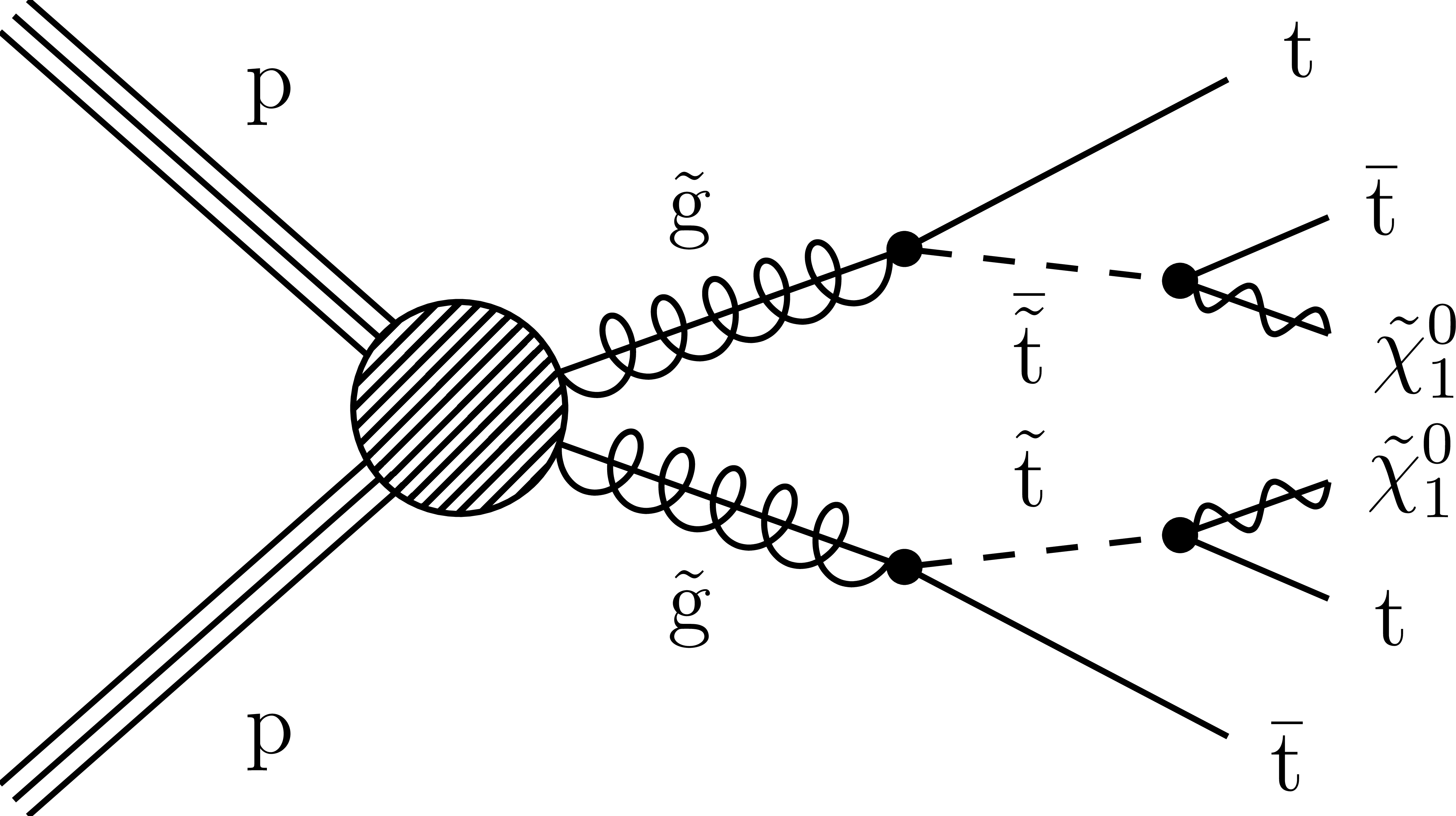
png pdf |
Figure 1-d:
Diagram representing a simplified model of direct and gluino-mediated top squark production considered in this study: the T5tttt model. |

png pdf |
Figure 1-e:
Diagram representing a simplified model of direct and gluino-mediated top squark production considered in this study: the T5ttcc model. |
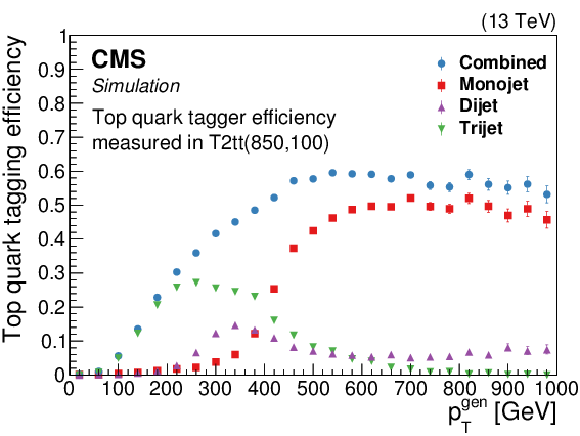
png pdf |
Figure 2:
Efficiency of the top quark tagger as a function of generator-level top quark $ {p_{\mathrm {T}}} $ for the monojet (red boxes), dijet (magenta triangles), and trijet (green upside-down triangles) categories and for their combination (blue circles), as determined using T2tt signal events with a top squark mass of 850 GeV and an LSP mass of 100 GeV. The vertical bars indicate the statistical uncertainties. |

png pdf |
Figure 3:
Search region definitions in the kinematic variables. The highest $ {{p_{\mathrm {T}}} ^\text {miss}} $, $ {m_{\mathrm {T2}}} $, and $ {H_{\mathrm {T}}} $ regions are open-ended, e.g., $ {{p_{\mathrm {T}}} ^\text {miss}} > $ 750 GeV and $ {m_{\mathrm {T2}}} > $ 750 GeV for search region 21. |

png pdf |
Figure 3-a:
Search region definitions in the kinematic variables. |
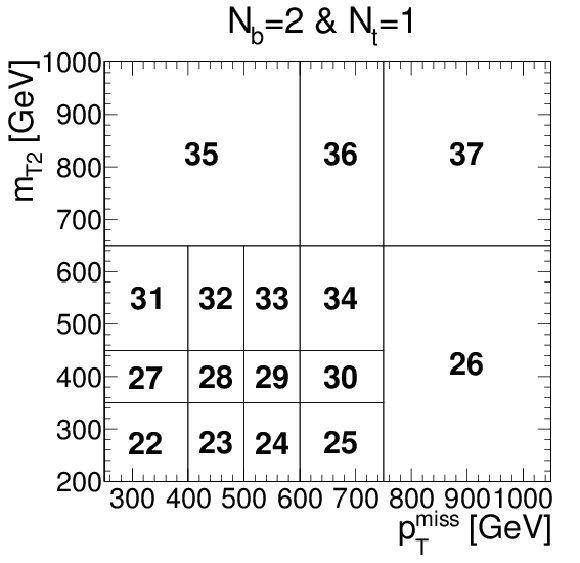
png pdf |
Figure 3-b:
Search region definitions in the kinematic variables. |
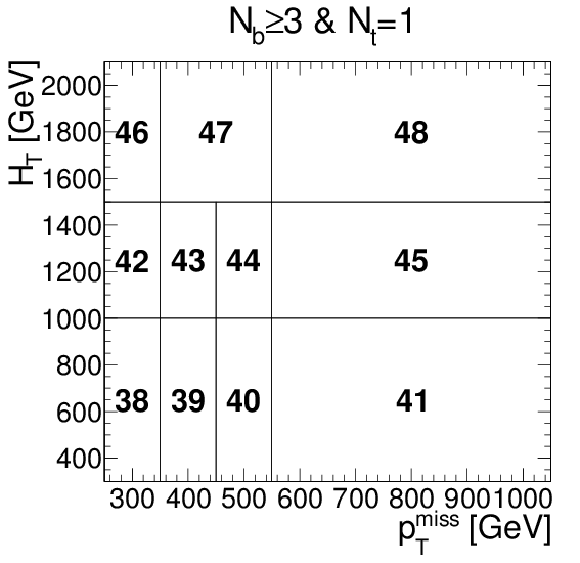
png pdf |
Figure 3-c:
Search region definitions in the kinematic variables. |

png pdf |
Figure 3-d:
Search region definitions in the kinematic variables. |
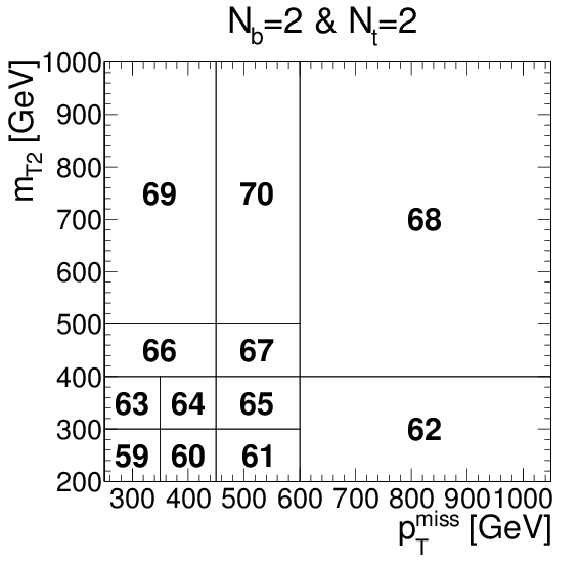
png pdf |
Figure 3-e:
Search region definitions in the kinematic variables. |

png pdf |
Figure 3-f:
Search region definitions in the kinematic variables. |
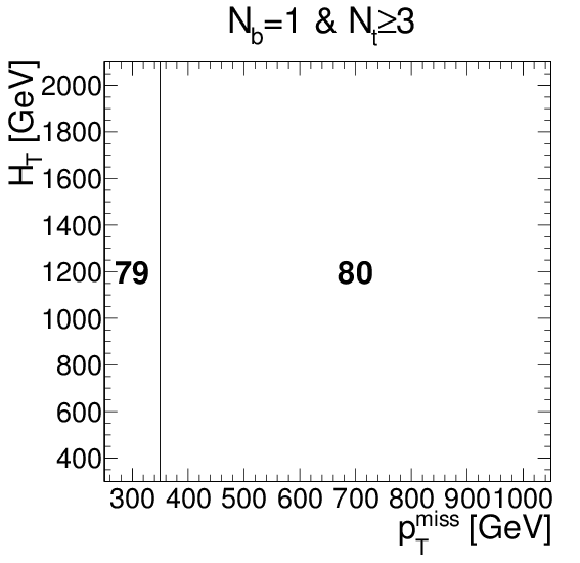
png pdf |
Figure 3-g:
Search region definitions in the kinematic variables. |

png pdf |
Figure 3-h:
Search region definitions in the kinematic variables. |
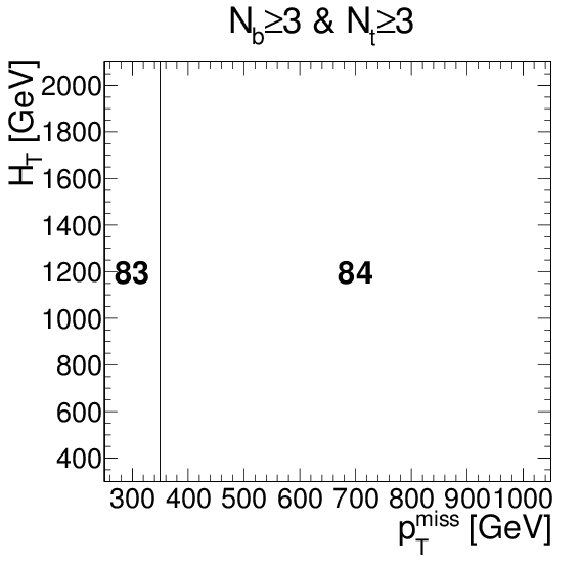
png pdf |
Figure 3-i:
Search region definitions in the kinematic variables. |
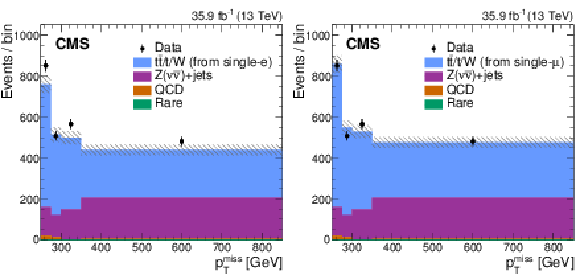
png pdf |
Figure 4:
Distribution of $ {{p_{\mathrm {T}}} ^\text {miss}} $ in the sideband data sample in comparison to predictions for SM processes. The prediction for $ {\mathrm{t} {}\mathrm{\bar{t}}} $, single top quark, and ${{{\mathrm{W}}\text {+jets}}}$ events is obtained using translation factors applied to a single-electron control sample (left) or to a single-muon control sample (right). The hatched bands indicate the statistical uncertainties in the total SM prediction. Note that the data and the predictions for all backgrounds except that for $ {\mathrm{t} {}\mathrm{\bar{t}}} $, single top quark, and W+jets events are identical between the left and right plots. |
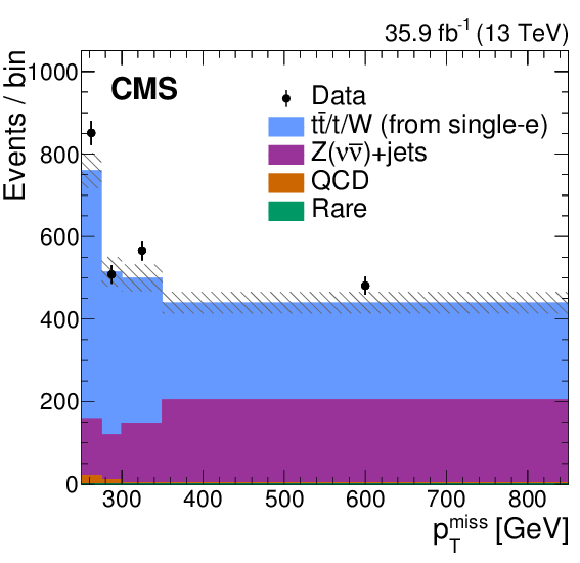
png pdf |
Figure 4-a:
Distribution of $ {{p_{\mathrm {T}}} ^\text {miss}} $ in the sideband data sample in comparison to predictions for SM processes. The prediction for $ {\mathrm{t} {}\mathrm{\bar{t}}} $, single top quark, and ${{{\mathrm{W}}\text {+jets}}}$ events is obtained using translation factors applied to a single-electron control sample. The hatched bands indicate the statistical uncertainties in the total SM prediction. Note that the data and the predictions for all backgrounds except that for $ {\mathrm{t} {}\mathrm{\bar{t}}} $, single top quark, and W+jets events are identical between the left and right plots. |
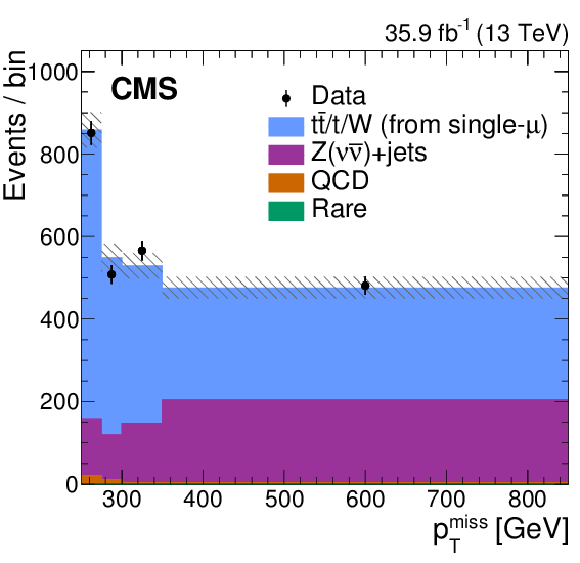
png pdf |
Figure 4-b:
Distribution of $ {{p_{\mathrm {T}}} ^\text {miss}} $ in the sideband data sample in comparison to predictions for SM processes. The prediction for $ {\mathrm{t} {}\mathrm{\bar{t}}} $, single top quark, and ${{{\mathrm{W}}\text {+jets}}}$ events is obtained using translation factors applied to a single-muon control sample. The hatched bands indicate the statistical uncertainties in the total SM prediction. Note that the data and the predictions for all backgrounds except that for $ {\mathrm{t} {}\mathrm{\bar{t}}} $, single top quark, and W+jets events are identical between the left and right plots. |

png pdf |
Figure 5:
The $ {{p_{\mathrm {T}}} ^\text {miss}} $ (left) and ${N_{\mathrm{b}}}$ (right) distributions of data and simulation in the loose dimuon control sample after applying a correction, as described in the text, to account for differences between the data and simulation for the ${N_{\text {j}}}$ distribution. The lower panels show the ratio between data and simulation. Only statistical uncertainties are shown. The values in parentheses indicate the integrated yields for each component. |

png pdf |
Figure 5-a:
The $ {{p_{\mathrm {T}}} ^\text {miss}} $ distribution of data and simulation in the loose dimuon control sample after applying a correction, as described in the text, to account for differences between the data and simulation for the ${N_{\text {j}}}$ distribution. The lower panel shows the ratio between data and simulation. Only statistical uncertainties are shown. The values in parentheses indicate the integrated yields for each component. |

png pdf |
Figure 5-b:
The ${N_{\mathrm{b}}}$ distribution of data and simulation in the loose dimuon control sample after applying a correction, as described in the text, to account for differences between the data and simulation for the ${N_{\text {j}}}$ distribution. The lower panel shows the ratio between data and simulation. Only statistical uncertainties are shown. The values in parentheses indicate the integrated yields for each component. |

png pdf |
Figure 6:
Observed event yields (black points) and prefit SM background predictions (filled solid areas) for the 84 search regions, where "prefit'' means there is no constraint from the likelihood fit. The lower panel shows the ratio of the data to the total background prediction. The hatched bands correspond to the total uncertainty in the background prediction. |

png pdf |
Figure 7:
Observed event yields (black points) and prefit SM background predictions (filled solid areas) for the 10 aggregate search regions, where "prefit'' means there is no constraint from the likelihood fit. The lower panel shows the ratio of the data to the total background prediction. The hatched bands correspond to the total uncertainty in the background prediction. |
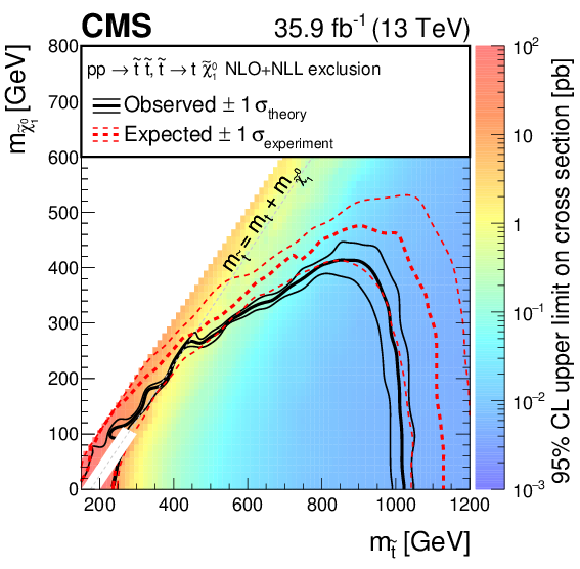
png pdf root |
Figure 8:
The 95% CL upper limit on the production cross section of the T2tt simplified model as a function of the top squark and LSP masses. The solid black curves represent the observed exclusion contour with respect to NLO+NLL signal cross sections and the change in this contour due to variation of these cross sections within their theoretical uncertainties[54]. The dashed red curves indicate the mean expected exclusion contour and the region containing 68% of the distribution of expected exclusion limits under the background-only hypothesis. No interpretation is provided for signal models for which $|m_{\tilde{\mathrm{t}}} - m_{\tilde{\chi}^0_1} - m_{\mathrm{t}}| \le $ 25 GeV and $m_{\tilde{\mathrm{t}}} \leq $ 275 GeV because signal events are essentially indistinguishable from SM $ {\mathrm{t} {}\mathrm{\bar{t}}} $ events in this region, rendering the signal event acceptance difficult to model. |

png pdf |
Figure 9:
The 95% CL upper limit on the production cross section of the T1tttt (upper left), T1ttbb (upper right), T5tttt (bottom left), and T5ttcc (bottom right) simplified models as a function of the gluino and LSP masses. The meaning of the curves is explained in the Fig. 8 caption. Limits are not given for the T5tttt model for $ {m_{\tilde{\chi}^0_1}} < $ 50 GeV for the reason stated in the text. |
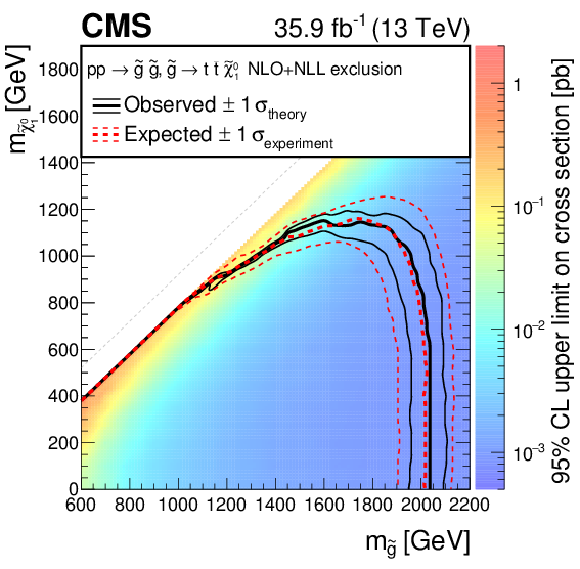
png pdf root |
Figure 9-a:
The 95% CL upper limit on the production cross section of the T1tttt simplified models as a function of the gluino and LSP masses. The meaning of the curves is explained in the Fig. 8 caption. Limits are not given for the T5tttt model for $ {m_{\tilde{\chi}^0_1}} < $ 50 GeV for the reason stated in the text. |
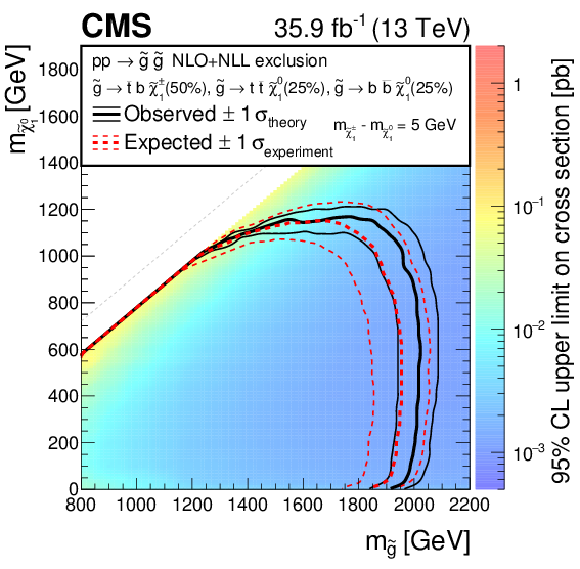
png pdf root |
Figure 9-b:
The 95% CL upper limit on the production cross section of the T1ttbb simplified models as a function of the gluino and LSP masses. The meaning of the curves is explained in the Fig. 8 caption. Limits are not given for the T5tttt model for $ {m_{\tilde{\chi}^0_1}} < $ 50 GeV for the reason stated in the text. |

png pdf root |
Figure 9-c:
The 95% CL upper limit on the production cross section of the T5tttt simplified models as a function of the gluino and LSP masses. The meaning of the curves is explained in the Fig. 8 caption. Limits are not given for the T5tttt model for $ {m_{\tilde{\chi}^0_1}} < $ 50 GeV for the reason stated in the text. |
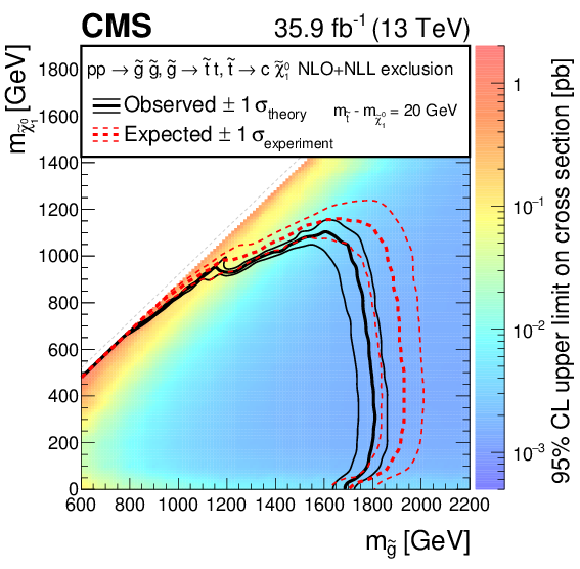
png pdf root |
Figure 9-d:
The 95% CL upper limit on the production cross section of the T5ttcc simplified models as a function of the gluino and LSP masses. The meaning of the curves is explained in the Fig. 8 caption. Limits are not given for the T5tttt model for $ {m_{\tilde{\chi}^0_1}} < $ 50 GeV for the reason stated in the text. |
| Tables | |

png pdf |
Table 1:
Definition of the aggregate search regions. |
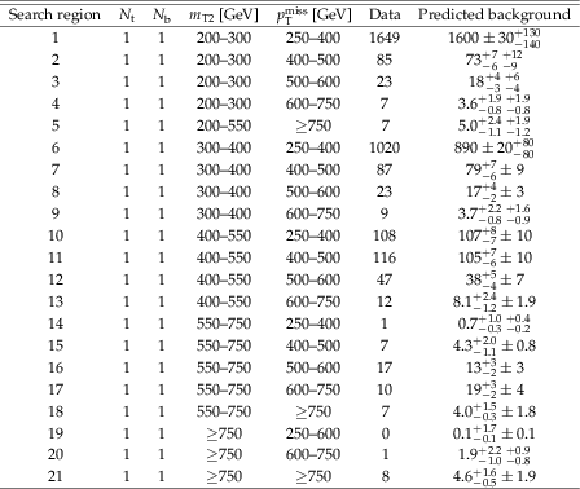
png pdf |
Table 2:
The observed number of events and the total background prediction for search regions with $ {N_{\mathrm{t}}} =$ 1 and $ {N_{\mathrm{b}}} =$ 1. The first uncertainty in the background prediction is statistical and the second is systematic. |

png pdf |
Table 3:
The observed number of events and the total background prediction for search regions with $ {N_{\mathrm{t}}} =$ 1 and $ {N_{\mathrm{b}}} \geq $ 2. The first uncertainty in the background prediction is statistical and the second is systematic. |
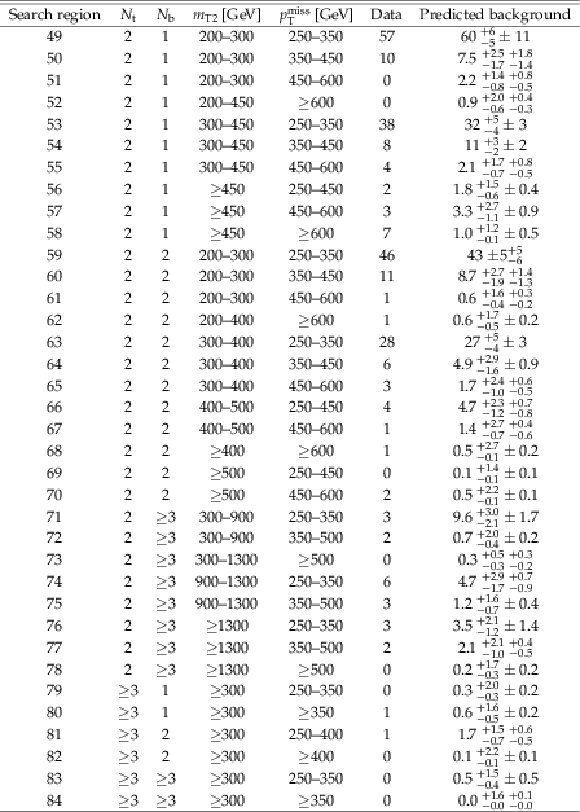
png pdf |
Table 4:
The observed number of events and the total background prediction for search regions with $ {N_{\mathrm{t}}} \geq $ 2. The first uncertainty in the background prediction is statistical and the second is systematic. |

png pdf |
Table 5:
The observed number of events and the total background prediction for the aggregate search regions. The first uncertainty in the background prediction is statistical and the second is systematic. |
| Summary |
|
Results are presented from a search for direct and gluino-mediated top squark production in proton-proton collisions at a center-of-mass energy of 13 TeV. The centerpiece of the analysis is a top quark tagging algorithm that identifies hadronically decaying top quarks with high efficiency across a wide range of top quark transverse momentum ${p_{\mathrm{T}}}$. The search is based on all-hadronic events with at least four jets, at least one tagged top quark, at least one tagged bottom quark jet, and a large imbalance in transverse momentum $ {p_{\mathrm{T}}}^{\text{miss}} $. The data correspond to an integrated luminosity of 35.9 fb$^{-1}$ collected with the CMS detector at the LHC in 2016. A set of 84 search regions is defined based on $ {p_{\mathrm{T}}}^{\text{miss}} $, the mass variable $ {m_{\mathrm{T2}}} $, the scalar ${p_{\mathrm{T}}} $ sum of jets $ {H_{\mathrm{T}}}$, the number of tagged top quarks, and the number of tagged bottom quark jets. No statistically significant excess of events is observed relative to the expectation from the standard model. Cross section upper limits at 95% confidence level are evaluated for a simplified model of direct top squark pair production, in which the top squarks decay to a top quark and the lightest supersymmetric particle (LSP) neutralino, and for simplified models of gluino pair production, in which the gluinos decay to final states containing top quarks and LSPs. Using the signal cross sections calculated with next-to-leading-order plus next-to-leading-logarithm accuracy, 95% confidence level lower limits are set on the masses of the top squark, the gluino, and the LSP. For the model of direct top squark pair production, top squark masses up to 1020 GeV and LSP masses up to 430 GeV are excluded. For the models of gluino pair production, gluinos with masses as large as 1810 to 2040 GeV are excluded, depending on the model, with corresponding exclusions for LSPs with masses as large as 1100 to 1150 GeV. These results significantly extend those of our previous study [19]. The use of top quark tagging provides a novel means to search for new phenomena at the LHC, yielding complementary sensitivity to other approaches. |
| Additional Figures | |
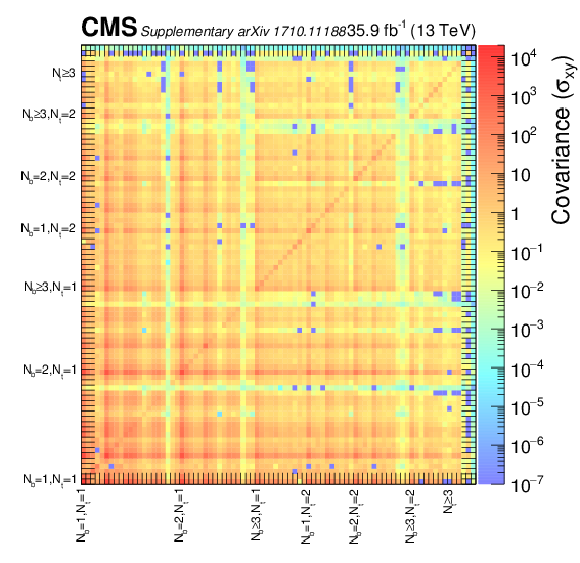
png pdf root |
Additional Figure 1:
Pre-fit background covariance matrix. |

png pdf root |
Additional Figure 2:
Pre-fit background correlation matrix. |

png pdf root |
Additional Figure 3:
SMS model significance for the SMS model of direct top squark production, with $\tilde{\mathrm{t}} \to \text {t} \tilde{\chi}_1^0$ decays (T2tt). |
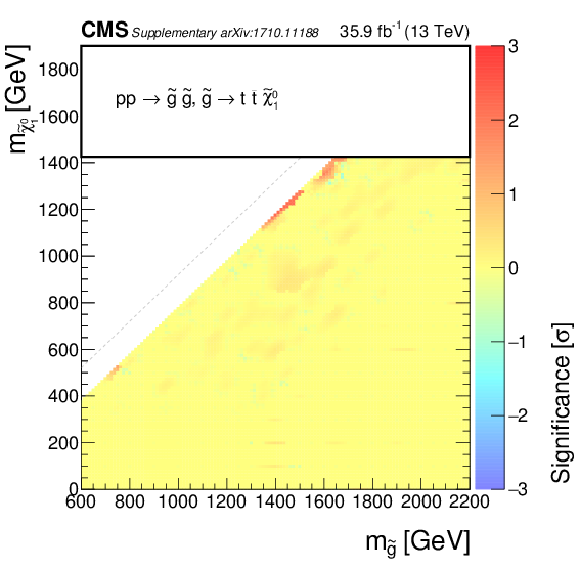
png pdf root |
Additional Figure 4:
SMS model significance for the SMS model of gluino production, with $\tilde{\mathrm{g}} \to \text {t} \overline {\text {t}} \tilde{\chi}_1^0$ decays (T1tttt). |

png pdf root |
Additional Figure 5:
SMS model significance for the SMS model of gluino production, with $\tilde{\mathrm{g}} \to \text {t} \tilde{\mathrm{t}}$, $\tilde{\mathrm{t}} \to \text {c} \tilde{\chi}_1^0$ decays (T5ttcc). |

png pdf root |
Additional Figure 6:
SMS model significance for the SMS model of gluino production, with $\tilde{\mathrm{g}} \to \text {t} \overline {\text {b}} \tilde{\chi}_1^0$ decays (T1tttt). |

png pdf root |
Additional Figure 7:
SMS model significance for the SMS model of gluino production, with $\tilde{\mathrm{g}} \to \text {t} \tilde{\mathrm{t}}$, $\tilde{\mathrm{t}} \to \text {t} \tilde{\chi}_1^0$ decays (T5tttt). |
| Additional Tables | |

png pdf |
Additional Table 1:
The cut flow for a few benchmark signal models of direct top squark production. For entries in the block labeled "Preselection requirements'', each efficiency is computed with respect to the previous one. For the other two blocks, all efficiencies are computed with respect to the last line of the "Preselection requirements'' block. |
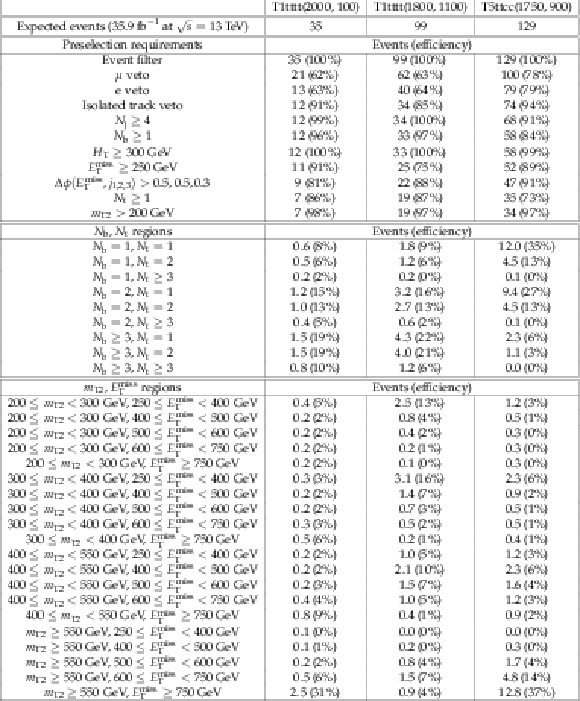
png pdf |
Additional Table 2:
The cut flow for a few benchmark signal models of gluino mediated top squark production. For entries in the block labeled "Preselection requirements'', each efficiency is computed with respect to the previous one. For the other two blocks, all efficiencies are computed with respect to the last line of the "Preselection requirements'' block. |

png pdf |
Additional Table 3:
Observed yields from the full 35.9 fb$^{-1}$ luminosity of data compared to our background predictions for all the aggregate search bins. |

png pdf |
Additional Table 4:
Selected T2tt signal yields for the aggregate search bins. |

png pdf |
Additional Table 5:
Selected gluino mediated signal yields for the aggregate search bins. |
|
Our simplified tagger code can be found in this github link. It can also be downloaded directly from here. We recommend a 3% uncertainty per tagged top to cover possible difference in efficiency between the simplified tagger and the tagger used in our main analysis. The simplified tagger uses the same framework as the full tagger described in the paper with the exception that the random forest (RF) decision tree used to identify trijet top candiates is retrained without using the quark-gluon likelihood values and replacing the combined-secondary-vertex (CSV) b-jet tagger discriminator with a binary discriminator (0 for not a b-jet, 1 for b-jet). This binary b-jet tagging discriminator uses the CMS CSVS ("medium") working point. ROOT files with efficiency maps for each search region bin for some of the simplified models are provided in the following files: - T2tt: acc_maps_T2tt.root - T1tttt: acc_maps_T1tttt.root - T5ttcc: acc_maps_T5ttcc.root |
| References | ||||
| 1 | ATLAS Collaboration | Observation of a new particle in the search for the Standard Model Higgs boson with the ATLAS detector at the LHC | PLB 716 (2012) 1 | 1207.7214 |
| 2 | CMS Collaboration | Observation of a new boson at a mass of 125 GeV with the CMS experiment at the LHC | PLB 716 (2012) 30 | CMS-HIG-12-028 1207.7235 |
| 3 | CMS Collaboration | Observation of a new boson with mass near 125 GeV in pp collisions at $ \sqrt{s} = $ 7 and 8 TeV | JHEP 06 (2013) 081 | CMS-HIG-12-036 1303.4571 |
| 4 | ATLAS and CMS Collaborations | Combined measurement of the Higgs boson mass in pp collisions at $ \sqrt{s}= $ 7 and 8 TeV with the ATLAS and CMS experiments | PRL 114 (2015) 191803 | 1503.07589 |
| 5 | R. Barbieri and G. F. Giudice | Upper bounds on supersymmetric particle masses | NPB 306 (1988) 63 | |
| 6 | P. Ramond | Dual theory for free fermions | PRD 3 (1971) 2415 | |
| 7 | Y. A. Gol'fand and E. P. Likhtman | Extension of the algebra of Poincar$ \'e $ group generators and violation of P invariance | JEPTL 13 (1971)323 | |
| 8 | D. V. Volkov and V. P. Akulov | Possible universal neutrino interaction | JEPTL 16 (1972) 438 | |
| 9 | J. Wess and B. Zumino | Supergauge transformations in four-dimensions | NPB 70 (1974) 39 | |
| 10 | P. Fayet | Supergauge invariant extension of the Higgs mechanism and a model for the electron and its neutrino | NPB 90 (1975) 104 | |
| 11 | R. Barbieri, S. Ferrara, and C. A. Savoy | Gauge models with spontaneously broken local supersymmetry | PLB 119 (1982) 343 | |
| 12 | A. H. Chamseddine, R. L. Arnowitt, and P. Nath | Locally supersymmetric grand unification | PRL 49 (1982) 970 | |
| 13 | L. J. Hall, J. D. Lykken, and S. Weinberg | Supergravity as the messenger of supersymmetry breaking | PRD 27 (1983) 2359 | |
| 14 | G. L. Kane, C. F. Kolda, L. Roszkowski, and J. D. Wells | Study of constrained minimal supersymmetry | PRD 49 (1994) 6173 | hep-ph/9312272 |
| 15 | M. Papucci, J. T. Ruderman, and A. Weiler | Natural SUSY endures | JHEP 09 (2012) 035 | 1110.6926 |
| 16 | CMS Collaboration | Search for supersymmetry in multijet events with missing transverse momentum in proton-proton collisions at $ 13{TeV} $ | Submitted to \it PRD | CMS-SUS-16-033 1704.07781 |
| 17 | CMS Collaboration | Search for new phenomena with the $ m_{\text{t2}} $ variable in the all-hadronic final state produced in proton-proton collisions at $ \sqrt{s} = 13{TeV} $ | Submitted to EPJC | CMS-SUS-16-036 1705.04650 |
| 18 | CMS Collaboration | Search for direct production of supersymmetric partners of the top quark in the all-jets final state in proton-proton collisions at $ \sqrt{s} = 13{TeV} $ | Accepted by \it JHEP | CMS-SUS-16-049 1707.03316 |
| 19 | CMS Collaboration | Search for supersymmetry in the all-hadronic final state using top quark tagging in pp collisions at $ \sqrt{s} = $ 13 TeV | PRD 96 (2017) 012004 | CMS-SUS-16-009 1701.01954 |
| 20 | C. G. Lester and D. J. Summers | Measuring masses of semi-invisibly decaying particles pair produced at hadron colliders | PLB 463 (1999) 99 | hep-ph/9906349 |
| 21 | A. Barr, C. Lester, and P. Stephens | A variable for measuring masses at hadron colliders when missing energy is expected; $ m_{T2} $: the truth behind the glamour | JPG 29 (2003) 2343 | hep-ph/0304226 |
| 22 | J. Alwall, P. Schuster, and N. Toro | Simplified models for a first characterization of new physics at the LHC | PRD 79 (2009) 075020 | 0810.3921 |
| 23 | J. Alwall, M.-P. Le, M. Lisanti, and J. G. Wacker | Model-independent jets plus missing energy searches | PRD 79 (2009) 015005 | 0809.3264 |
| 24 | LHC New Physics Working Group Collaboration | Simplified models for LHC new physics searches | JPG 39 (2012) 105005 | 1105.2838 |
| 25 | D. Alves, E. Izaguirre, and J. G. Wacker | Where the sidewalk ends: jets and missing energy search strategies for the 7 TeV LHC | JHEP 10 (2011) 012 | 1102.5338 |
| 26 | CMS Collaboration | Interpretation of searches for supersymmetry with simplified models | PRD 88 (2013) 052017 | CMS-SUS-11-016 1301.2175 |
| 27 | CMS Collaboration | The CMS experiment at the CERN LHC | JINST 3 (2008) S08004 | CMS-00-001 |
| 28 | CMS Collaboration | The CMS trigger system | JINST 12 (2017) P01020 | CMS-TRG-12-001 1609.02366 |
| 29 | CMS Collaboration | Particle-flow reconstruction and global event description with the CMS detector | JINST 12 (2017) P10003 | CMS-PRF-14-001 1706.04965 |
| 30 | CMS Collaboration | Performance of electron reconstruction and selection with the CMS detector in proton-proton collisions at $ \sqrt{s} = $ 8 TeV | JINST 10 (2015) P06005 | CMS-EGM-13-001 1502.02701 |
| 31 | CMS Collaboration | The performance of the CMS muon detector in proton-proton collisions at $ \sqrt{s} = $ 7 TeV at the LHC | JINST 8 (2013) P11002 | CMS-MUO-11-001 1306.6905 |
| 32 | M. Cacciari, G. P. Salam, and G. Soyez | The anti-$ k_t $ jet clustering algorithm | JHEP 04 (2008) 063 | 0802.1189 |
| 33 | CMS Collaboration | Jet performance in pp collisions at 7 TeV | CMS-PAS-JME-10-003 | |
| 34 | M. Cacciari and G. P. Salam | Pileup subtraction using jet areas | PLB 659 (2007) 119 | 0707.1378 |
| 35 | M. Cacciari, G. P. Salam, and G. Soyez | FastJet user manual | EPJC 72 (2012) 1896 | 1111.6097 |
| 36 | CMS Collaboration | Jet energy scale and resolution in the CMS experiment in pp collisions at 8 TeV | JINST 12 (2017) P02014 | CMS-JME-13-004 1607.03663 |
| 37 | CMS Collaboration | Identification of b quark jets at the CMS experiment in the LHC Run 2 | CMS-PAS-BTV-15-001 | CMS-PAS-BTV-15-001 |
| 38 | CMS Collaboration | Identification of b-quark jets with the CMS experiment | JINST 8 (2013) P04013 | CMS-BTV-12-001 1211.4462 |
| 39 | D. Bertolini, P. Harris, M. Low, and N. Tran | Pileup per particle identification | JHEP 10 (2014) 059 | 1407.6013 |
| 40 | CMS Collaboration | Study of pileup removal algorithms for jets | CMS-PAS-JME-14-001 | CMS-PAS-JME-14-001 |
| 41 | UA1 Collaboration | Experimental observation of isolated large transverse energy electrons with associated missing energy at $ \sqrt{s}= $ 540 GeV | PLB 122 (1983) 103 | |
| 42 | J. Alwall et al. | The automated computation of tree-level and next-to-leading order differential cross sections, and their matching to parton shower simulations | JHEP 07 (2014) 079 | 1405.0301 |
| 43 | J. Alwall et al. | Comparative study of various algorithms for the merging of parton showers and matrix elements in hadronic collisions | EPJC 53 (2008) 473 | 0706.2569 |
| 44 | NNPDF Collaboration | Parton distributions for the LHC Run II | JHEP 04 (2015) 040 | 1410.8849 |
| 45 | P. Nason | A new method for combining NLO QCD with shower Monte Carlo algorithms | JHEP 11 (2004) 040 | hep-ph/0409146 |
| 46 | S. Frixione, P. Nason, and C. Oleari | Matching NLO QCD computations with Parton Shower simulations: the POWHEG method | JHEP 11 (2007) 070 | 0709.2092 |
| 47 | S. Alioli, P. Nason, C. Oleari, and E. Re | A general framework for implementing NLO calculations in shower Monte Carlo programs: the POWHEG BOX | JHEP 06 (2010) 043 | 1002.2581 |
| 48 | E. Re | Single-top $ Wt $-channel production matched with parton showers using the POWHEG method | EPJC 71 (2011) 1547 | 1009.2450 |
| 49 | R. Frederix and S. Frixione | Merging meets matching in MC@NLO | JHEP 12 (2012) 061 | 1209.6215 |
| 50 | T. Sjostrand, S. Mrenna, and P. Z. Skands | A brief introduction to PYTHIA 8.1 | CPC 178 (2008) 852 | 0710.3820 |
| 51 | CMS Collaboration | Event generator tunes obtained from underlying event and multiparton scattering measurements | EPJC 76 (2016) 155 | CMS-GEN-14-001 1512.00815 |
| 52 | GEANT4 Collaboration | GEANT4---a simulation toolkit | NIMA 506 (2003) 250 | |
| 53 | S. Abdullin et al. | The fast simulation of the CMS detector at LHC | J. Phys. Conf. Ser. 331 (2011) 032049 | |
| 54 | C. Borschensky et al. | Squark and gluino production cross sections in pp collisions at $ \sqrt{s} $ = 13, 14, 33 and 100 TeV | EPJC 74 (2014) 3174 | 1407.5066 |
| 55 | M. Czakon and A. Mitov | Top++: A program for the calculation of the top-pair cross-section at hadron colliders | CPC 185 (2014) 2930 | 1112.5675 |
| 56 | P. Kant et al. | HATHOR for single top-quark production: Updated predictions and uncertainty estimates for single top-quark production in hadronic collisions | CPC 191 (2015) 74 | 1406.4403 |
| 57 | M. Aliev et al. | HATHOR: HAdronic Top and Heavy quarks crOss section calculatoR | CPC 182 (2011) 1034 | 1007.1327 |
| 58 | T. Gehrmann et al. | W$ ^+ $W$ ^- $ production at hadron colliders in next to next to leading order QCD | PRL 113 (2014) 212001 | 1408.5243 |
| 59 | J. M. Campbell and R. K. Ellis | An update on vector boson pair production at hadron colliders | PRD 60 (1999) 113006 | hep-ph/9905386 |
| 60 | J. M. Campbell, R. K. Ellis, and C. Williams | Vector boson pair production at the LHC | JHEP 07 (2011) 018 | 1105.0020 |
| 61 | Y. Li and F. Petriello | Combining QCD and electroweak corrections to dilepton production in FEWZ | PRD 86 (2012) 094034 | 1208.5967 |
| 62 | CMS Collaboration | Top tagging with new approaches | CMS-PAS-JME-15-002 | CMS-PAS-JME-15-002 |
| 63 | ATLAS Collaboration | Identification of high transverse momentum top quarks in pp collisions at $ \sqrt{s} = $ 8 TeV with the ATLAS detector | JHEP 06 (2016) 093 | 1603.03127 |
| 64 | M. Dasgupta, A. Fregoso, S. Marzani, and G. P. Salam | Towards an understanding of jet substructure | JHEP 09 (2013) 029 | 1307.0007 |
| 65 | A. J. Larkoski, S. Marzani, G. Soyez, and J. Thaler | Soft drop | JHEP 05 (2014) 146 | 1402.2657 |
| 66 | CMS Collaboration | Jet algorithms performance in 13 TeV data | CMS-PAS-JME-16-003 | CMS-PAS-JME-16-003 |
| 67 | Y. L. Dokshitzer, G. D. Leder, S. Moretti, and B. R. Webber | Better jet clustering algorithms | JHEP 08 (1997) 001 | hep-ph/9707323 |
| 68 | M. Wobisch and T. Wengler | Hadronization corrections to jet cross sections in deep- inelastic scattering | hep-ph/9907280 | |
| 69 | J. Thaler and K. Van Tilburg | Identifying boosted objects with N-subjettiness | JHEP 03 (2011) 015 | 1011.2268 |
| 70 | Particle Data Group, C. Patrignani et al. | Review of particle physics | CPC 40 (2016) 100001 | |
| 71 | T. K. Ho | Random decision forests | Proceedings of 3rd International Conference on Document Analysis and Recognition 1 (1995) 278 | |
| 72 | CMS Collaboration | Performance of quark/gluon discrimination in 8 TeV pp data | CMS-PAS-JME-13-002 | CMS-PAS-JME-13-002 |
| 73 | T. Junk | Confidence level computation for combining searches with small statistics | NIMA 434 (1999) 435 | hep-ex/9902006 |
| 74 | A. L. Read | Presentation of search results: the $ CL_s $ technique | JPG 28 (2002) 2693 | |
| 75 | ATLAS and CMS Collaborations | Procedure for the LHC Higgs boson search combination in summer 2011 | ATL-PHYS-PUB-2011-011, CMS NOTE-2011/005 | |
| 76 | G. Cowan, K. Cranmer, E. Gross, and O. Vitells | Asymptotic formulae for likelihood-based tests of new physics | EPJC 71 (2011) 1554 | 1007.1727 |
| 77 | CMS Collaboration | CMS luminosity measurements for the 2016 data taking period | CMS-PAS-LUM-17-001 | CMS-PAS-LUM-17-001 |
| 78 | CMS Collaboration | Search for physics beyond the standard model in events with two leptons of same sign, missing transverse momentum, and jets in proton-proton collisions at $ \sqrt{s}=13{TeV} $ | EPJC 77 (2017) 578 | CMS-SUS-16-035 1704.07323 |

|
Compact Muon Solenoid LHC, CERN |

|

|

|

|

|

|